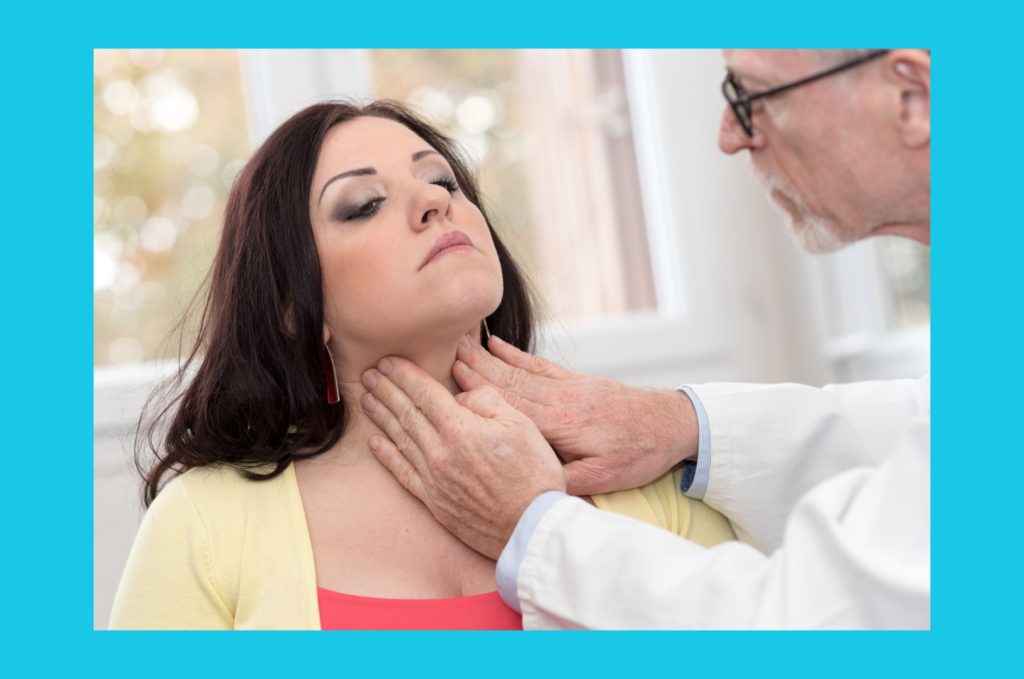This is my first post on diseases nurses often see in practice. I hope you enjoy the review. As a nurse, understanding the patient’s health conditions is a priority in providing safe care.
Thyroid disorders affect many individuals. These disorders can manifest as hyperthyroidism, hypothyroidism, inflammation, malignancy, or enlargement. According to the American Thyroid Association (2022), more than 12% of Americans will suffer from thyroid disease. Many are undiagnosed. Hypothyroidism is the most common thyroid disorder seen in 5 out of 100 people over 12 years of age (NIDDK, n.d.). Many thyroid disorders are lifelong. This post will discuss two of the most common thyroid disorders: hypo and hyperthyroidism. Nurses often see patients with a history of thyroid disease, and ensuring ongoing treatment for thyroid disorders is a priority.
The Thyroid Gland
The thyroid gland is located in the anterior neck, just in front of the trachea and below the larynx. The butterfly-shaped organ consists of two encapsulated lobes on either side. The gland is highly vascular. The functional unit of the thyroid is the follicle which consists of epithelial cells. These cells are around a hollow vesicle filled with thyroglobulin, a large protein produced by the thyroid. Thyroid hormones (T3 and T4) are produced in the thyroid and bind to thyroglobulin for storage. Iodine is an essential element in the production of these hormones.
The role of the thyroid gland is to control and maintain metabolism. It does this through the production of thyroid hormones thyroxine (T4) and triiodothyronine (T3). T4 is primarily secreted directly from the thyroid gland. About 95% of the thyroid hormone released directly from the thyroid gland is thyroxine (T4). However, T3 is a more potent hormone. Very little is formed and released by the thyroid. But T4 is broken down in the tissues to T3, so the actions of T3 and T4 in the body are about 50/50.
A negative feedback mechanism regulates the thyroid. Low circulating thyroid hormones in the blood stimulate the hypothalamus to secrete thyroid-releasing hormone (TRH). TRH, in turn, stimulates the pituitary to release thyroid-stimulating hormone (TSH). TSH stimulates the thyroid to produce thyroid hormones. High circulating thyroid hormones depress the mechanism.

Hypothyroidism
Hypothyroidism means a low level of thyroid hormone is present. There are many causes. They include autoimmune disorders, family tendency, iodine deficiency, congenital abnormalities, or iatrogenic causes (from treatment of hyperthyroidism or cancer). Chronic or critical illness may also affect thyroid function. When inadequate thyroid hormones are released, the negative feedback mechanism will attempt to raise hormone release. But, if the thyroid can’t respond, the TSH level in the blood rises. TSH is one of the first diagnostic studies indicating hypothyroidism.
Some of the many signs and symptoms of hypothyroidism include fatigue, dry skin, dry, brittle hair and hair loss, feeling cold, weight gain, peripheral edema, constipation, and decreased ability to concentrate. Some people may experience dyspnea and a hoarse voice. Significantly low thyroid hormone levels can lead to a decline in the level of consciousness, bradycardia, and heart failure. Severe hypothyroidism is called myxedema coma. Although rare, the condition is life-threatening. (Jameson et al., 2022).
Treatment of hypothyroidism is thyroid hormone replacement, usually levothyroxine. The oral medication is taken daily. When patients are hospitalized, nurses must ensure the medication continues to prevent recurrent hypothyroidism. Lack of thyroid hormone is related to hypotension, slow weaning from mechanical ventilation, and decreased recovery from critical illness.

Hyperthyroidism
Hyperthyroidism occurs when the thyroid hormone level is too high. One cause is Graves’ Disease, named for Robert Graves, who first identified the disease in 1835. Graves’ disease is the most common cause of hyperthyroidism. It accounts for about 90% of cases in those under 40 years (Goroll and Mulley, 2000) and about 75% of all patients with hyperthyroidism (Cobin and Wiesen, 1999). It is an autoimmune condition in which an apparent deficiency of thyroid-specific suppressor T-cell lymphocytes allow a thyroid-stimulating antibody (TSab) to form. TSab binds to thyroid cells and, acting like TSH, stimulates the production of thyroid hormones (Copstead, 1995; Guyton, 1991).
Common symptoms of the hypermetabolic state of hyperthyroidism include:
Muscle weakness Eye symptoms (exopthalmos, burning, tearing, stare, lid lag) Diplopia
Fatigue
Heat Intolerance
Warm, silky skin Decreased or absent menses
Dyspnea Susceptibility to infection
Tachycardia Goiter
Palpitations Angina
Laboratory tests obtained if one is questioning the presence of Graves’ Disease include serum TSH, free T4, and T3 levels, total T3 and T4 levels, and antithyroid antibodies. Other diagnostic tests for thyroid function are radioactive iodine uptake, thyroid scan, and ECG.
Complications may develop in the patient with Graves’ Disease. Thyroid storm is one such complication. It is a life-threatening emergency. It affects those who are in poor health and is precipitated by infections, myocardial infarction, diabetic emergencies, and pregnancy. Patients who also stop treatment for the disease may also develop thyroid storm.
Patients present with fever, agitation, abdominal pain, rapid heart rate, heart failure, and may quickly advance to shock and coma. Therapy is directed at fever reduction, fluid replacement, and managing the initiating stressor. Other complications of hyperthyroidism include atrial fibrillation. Fortunately, 60% of patients with atrial fibrillation due to hyperthyroidism return to normal sinus rhythm within a few weeks of returning to a euthyroid state (Toft and Boon, 2000). Some patients may develop heart failure as a result of hyperthyroidism. Chronic hyperthyroidism can also lead to decreased bone density and a higher incidence of hip and vertebral fractures. (Thyroxine has an osteoclastic action.)
Treatment of the condition may be managed by the primary care provider or referred to an endocrinologist. Treatment may include:
- Beta-blocking agents to inhibit the adrenergic effects of excess thyroid hormone.
- Antithyroid medications to suppress the synthesis of T4 and circulating TSab.
- Radioactive iodine therapy (thyroid ablation) with Iodine I-131.
- Surgical removal of the thyroid
- Screening for osteoporosis
- High-calorie diet with 1-2 g/protein/kg. Encourage the patient to avoid caffeine.
- Follow-up and referral for those who are candidates for radioactive iodine therapy or surgery. Refer patients with complications (heart failure, angina, ophthalmopathy, etc) and pregnant or lactating patients.

Treatment: Thyroid Ablation
Thyroid ablation using radioiodine I-131 is the most effective treatment for the patient seen in the clinic. . Physicians in the U.S. often choose this method over antithyroid medications (Fatourechi, 2000), This treatment consists of orally administered radioactive iodine that ablates the thyroid.
The most commonly reported acute complication of thyroid ablation is sialoadenitis (pain, tenderness, and swelling of the salivary glands) (Williams, 1996). This happens in less than 10-11% of cases. Other adverse reactions include radiation parotiditis, loss of taste (acute or chronic), radiation gastritis with nausea and vomiting (< 1%), bone marrow suppression, radiation pneumonitis, radiation cystitis, transient amenorrhea, and thyroid storm that can occur 2-10 days after treatment.
The risk of sialoadenitis is reduced by encouraging fluids and encouraging patients to suck on hard sour candy or pickles to promote salivary secretions for 24 hours after administering the I-131.
Radiation gastritis is lessened by increasing fluid intake. Antacids and antiemetics also be prescribed. (Williams, 1996; Thyroid Cancer Collaborative Practice Group, 2002).
References
American Thyroid Association. (2022). General information/press room.
Jameson, J., Mandel, S.J., & Weetman, A.P. (2022). Hypothyroidism. Loscalzo, J., Fauci, A., Kasper, D., Hauser, S., Longo, D., & Jameson, J. (Eds.). Harrison’s Principles of Internal Medicine (21 ed.). McGraw Hill.
National Institute of Diabetes and Digestive and Kidney Diseases (NIDDK). (n.d.). Hypothyroidism (Underactive Thyroid). https://www.niddk.nih.gov/health-information/endocrine-diseases/hypothyroidism#common

